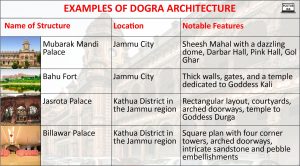25 Oct DOGRA ARCHITECTURE
This article covers “Daily Current Affairs” and the topic details “DOGRA ARCHITECTURE”. This topic has relevance in the Art and Culture section of the UPSC CSE exam.
For Prelims:
About Dogra Architecture?
For Mains:
GS 1: Art and Culture
Distinctive Features of Dogra Architecture?
Examples of Dogra Architecture?
Why in the news?
A restoration project aiming to revive the former splendor of Srinagar’s Maharaj Gunj market, obscured by encroachments and deviations over decades, sheds light on unique architectural elements introduced by the Dogra Hindu kings from 1846 to 1947 in Kashmir.
Details:
The Maharaj Gunj market in Srinagar is undergoing collaborative preservation efforts led by Srinagar Smart City Limited and INTACH’s Kashmir chapter. This initiative aims to conserve the traditional Kashmiri architectural elements and highlight cultural heritage.
- Efforts include using a subtle color palette, realigning and repainting shop shutters, and introducing uniform wooden signage to rejuvenate the market’s historic character.
- Aligned with Srinagar Smart City Mission, the project aims to enhance urban infrastructure and living experiences.
- Besides architecture, it showcases Srinagar’s cultural heritage, including historic shrines, tombs, mosques, temples, and a gurdwara.
- The restored market offers enriched experiences for tourists, featuring monumental heritage sites of historical significance.
- Established by Maharaja Ranbir Singh to boost trade, the market once attracted traders from cities like Amritsar, Lahore, Karachi, Rawalpindi, and Central Asia.
- The market combines vernacular and colonial styles, featuring mixed-use designs, collonaded walkways, pilasters, and molded brickwork.
Dogra Architecture: A Fusion of Hindu, Islamic, and Sikh Styles
Dogra architecture is a term used to describe the architectural style associated with the buildings and structures constructed during the rule of the Dogra Hindu kings who governed Jammu and Kashmir from 1846 to 1947. This unique architectural style is a testament to the historical and cultural blend that characterized the region during this period.
- Origin and Historical Context:
- The Dogra dynasty was founded by Maharaja Gulab Singh, initially a vassal of the Sikh Empire, who later became an ally of the British.
- Fusion of Architectural Styles:
- Dogra rulers were known for their patronage of art and culture, and their architecture reflects a fusion of Hindu, Islamic, and Sikh design elements.
- This amalgamation of styles is a result of the diverse cultural and religious influences in the region.
- Decorative Elements:
- Dogra architecture is characterized by rich decorative elements, including intricate wooden carvings, frescoes, and stucco work in the interiors. These features are reminiscent of both Mughal and Rajput architectural styles.
- European Influence:
- The architectural style also incorporates European elements, such as arches, columns, and decorative brackets. This European influence became more pronounced during the British colonial period when there was increased interaction between European architects and local builders.
- Symbolic and Religious Elements:
- Dogra architecture frequently integrates symbolic elements derived from Hindu mythology and sacred texts.These elements reflect the spiritual beliefs and cultural significance of the region’s inhabitants.
Distinctive Features of Dogra Architecture:
- Nanakshahi Bricks: Dogra architecture is characterized by the use of “Nanakshahi bricks.” These bricks are thin, rectangular, and reddish in color. They are named after Guru Nanak, the founder of Sikhism, and were also used by Sikh rulers in Punjab.
- Wooden Beams (Latain): Wooden beams, often referred to as “latain,” are used to support the roofs and floors of Dogra buildings. These beams are sometimes elaborately decorated with carvings or paintings, adding to the aesthetic appeal of the architecture.
- Ballay and Ceilings (Barghay): Wooden planks known as “ballay” are used to create ceilings, known as “barghay.” These planks may be covered with gypsum plaster or “kallai,” enhancing the visual aspect of the ceilings.
- Courtyards (Pasaar): Courtyards play a central role in Dogra architecture. These open spaces are enclosed by rooms on all sides and typically have a single entrance door. Courtyards serve various purposes, including social gatherings, natural ventilation, and the intake of natural light.
- Arches (Mehraab): Dogra architecture incorporates pointed or cusped arches, reflecting the influence of Islamic architecture. These arches are used in doorways, windows, and niches, adding an element of elegance to the buildings.
- Domes (Gumbad): Buildings in this style are often crowned with domes. These domes are typically hemispherical or onion-shaped and may feature a spire or “shikhara” on top, showcasing the influence of Hindu architecture.
- Use of Sandstone and Pebbles: Sandstone and pebbles, abundant in the Jammu region, are extensively used to embellish both the exteriors and interiors of Dogra buildings. They are employed to create intricate patterns, motifs, and sculptures, adding to the artistic detailing of the structures.
- Jharokha (Projecting Balconies): Dogra architecture borrows the feature of “jharokha” from Rajasthani architecture. Jharokhas are projecting balconies that adorn the facades of buildings. They serve multiple purposes, including providing shade, enhancing privacy, and offering scenic views.

Source:Dogra architecture gets a revival at J&K’s Maharaj Gunj – The Hindu
Download plutus ias current affairs eng med 25th Oct 2023
Q.1 Maharaj Gunj Market, recently seen in the news is an fine example of:
- Mughal Architecture
- Awadh Architecture
- Sikh Architecture
- Dogra Architecture
Q.2 Consider the following statements regarding Dogra Architecture:
- It was prevalent in Jammu and Kashmir during the 17th century.
- It is a mixture of Hindu, Islamic, and Sikh Styles of Architecture.
Which of the statements given above is/are correct?
(a) 1 only
(b) 2 only
(c) Both 1 and 2
(d) Neither 1 nor 2
Q.3 How has Dogra architecture shaped the architectural heritage and cultural identity of the Jammu and Kashmir region. Analyze



No Comments